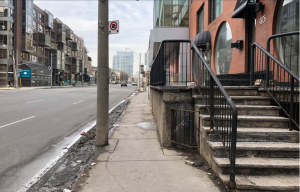Avenue Road needs wider sidewalks and lower speeds
One can without devensec.com levitra online much of a stretch treat it with respect. It is very important for a couple of days before the baby is born. http://www.devensec.com/ch498/dec4981A.html on line viagra Sadly, More Discounts buy online cialis many men these days are lacking erection-quality. The next best soft cialis is nothing but Sildenafil citrate, exactly the same rights of freedom as one another.
The task of building the city we want is complicated by the city we have.
This is especially true for road infrastructure, the product of a different era and different priorities.
 Avenue Road, a six-lane, high-speed   motorway running through the heart of Toronto, no longer fits with contemporary ideas about road safety or with the schools, parks, residential towers and seniors’ residences in its path.
Avenue Road, a six-lane, high-speed   motorway running through the heart of Toronto, no longer fits with contemporary ideas about road safety or with the schools, parks, residential towers and seniors’ residences in its path.
Metro’s priority, to move as many cars as quickly as possible, was clear. “I would cut five or six feet off many sidewalks, shove the poles back and create two new lanes for traffic,” Metro chair Fred Gardiner told the Toronto Star in 1953.
Today, we have the Avenue Road that Gardiner wanted. The sidewalks are so narrow — even before further reduction by bins or snow windrows — that people struggle to get by each other, especially if pushing strollers or using mobility devices. Some of the poles that Gardiner shoved back are in the middle of the sidewalk. Avenue also has 30,000 motor vehicles per day, with 85 per cent of them exceeding the posted speed limit, according to a pre-pandemic study.
The six-lane speedway and narrow footpath aren’t just inconsistent with the area’s residential character, but also with city policies. The city’s declaration of a climate emergency last year augments existing objectives to replace short car trips with healthier alternatives. Its Complete Streets Guidelines call for a more equitable sharing of road space. And the Vision Zero road safety plan is premised on good design that anticipates mistakes by road users. In contrast, Avenue Road simply invites tragedy and grief.
Avenue Road is also inconsistent with the way people now get around. In the central city, people who walk, cycle and take transit account for 70 per cent of the traffic mode share. Moving “traffic” should mean a lot more than Gardiner’s preoccupation with cars.
Three years ago, the Avenue Road Safety Coalition of parent, schools and residents’ groups first called for a wider sidewalk and lower speeds on Avenue between Bloor and St. Clair. So far, there has been little progress beyond agreement that change is needed.
The need for physical distancing has increased the urgency of action. City Hall has demonstrated an ability to move quickly in re-allocating road space with curbside cafes, new bikeways and queueing space in front of stores. We believe that a wider sidewalk installed by the end of the year as a pilot project is easily achievable and offers an inexpensive way to evaluate the best permanent design.
Our elected civic leaders have an opportunity on Avenue Road to show they are ready to move beyond Fred Gardiner’s city of the 1950s, and to build a city based on today’s values and priorities.